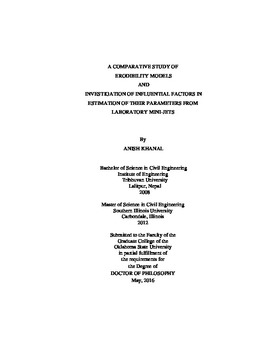| dc.contributor.advisor | Fox, Garey | |
| dc.contributor.author | Khanal, Anish | |
| dc.date.accessioned | 2017-02-22T22:09:51Z | |
| dc.date.available | 2017-02-22T22:09:51Z | |
| dc.date.issued | 2016-05 | |
| dc.identifier.uri | https://hdl.handle.net/11244/48828 | |
| dc.description.abstract | Modeling and predicting detachment of cohesive particles and consequently erosion of cohesive soil mass remains an unconquered problem. The linear excess shear stress model and the non-linear Wilson model are some of the prominent process based models used extensively. The parameters of these models can be statistically estimated from various experimental methods like the Jet Erosion Test (JET). A miniaturized version of the JETS called the mini-JETs has added advantage of portability and in-situ use. However, lack of a standard operating procedure can lead to wide variability in estimation of the parameters of the erodibility equation. Besides the operation of the device, analysis procedure of the data obtained from the JETs is also not adequately established. This study focused on the mini-JET device and the parameters of the erodibility equation. Precision of the mini-JET in terms of the parameters of the erodibility models was calculated. Recommendations were made regarding the head setting, initial interval and termination interval to establish uniformity in operation of the mini-JET. The influence of vegetation roots on the parameters of the erodibility equations was also quantified using the mini-JET and correlations between root properties and the erodibility parameters were identified. The influence of the moisture content on the soil erodibility was investigated in terms of the parameters of the erodibility equation using the mini-JET. Different solution techniques to derive the parameters of the linear model were compared with respect to the variability of the parameters. The performance of the linear model and non-linear model was applied in a reach scale stream bank stability simulation in order to evaluate their performance in an application setting. The non-linear model was shown to be more appropriate than the linear model in predicting the erosion rates at a wider range of applied shear stress. This research highlighted the usefulness of the mini-JET in modeling the detachment of cohesive soil and advantages of using the non-linear model in modeling long term streambank retreat. This study also identified the critical areas of research to further improve the process based approach to modeling the erosion of cohesive soil. | |
| dc.format | application/pdf | |
| dc.language | en_US | |
| dc.rights | Copyright is held by the author who has granted the Oklahoma State University Library the non-exclusive right to share this material in its institutional repository. Contact Digital Library Services at lib-dls@okstate.edu or 405-744-9161 for the permission policy on the use, reproduction or distribution of this material. | |
| dc.title | Comparative study of erodibility models and investigation of influential factors in estimation of their parameters from laboratory mini-jets | |
| dc.contributor.committeeMember | Storm, Daniel | |
| dc.contributor.committeeMember | Hunt, Sherry | |
| dc.contributor.committeeMember | Bulut, Rifat | |
| osu.filename | Khanal_okstate_0664D_14648.pdf | |
| osu.accesstype | Open Access | |
| dc.type.genre | Dissertation | |
| dc.type.material | Text | |
| thesis.degree.discipline | Biosystems Engineering | |
| thesis.degree.grantor | Oklahoma State University | |
